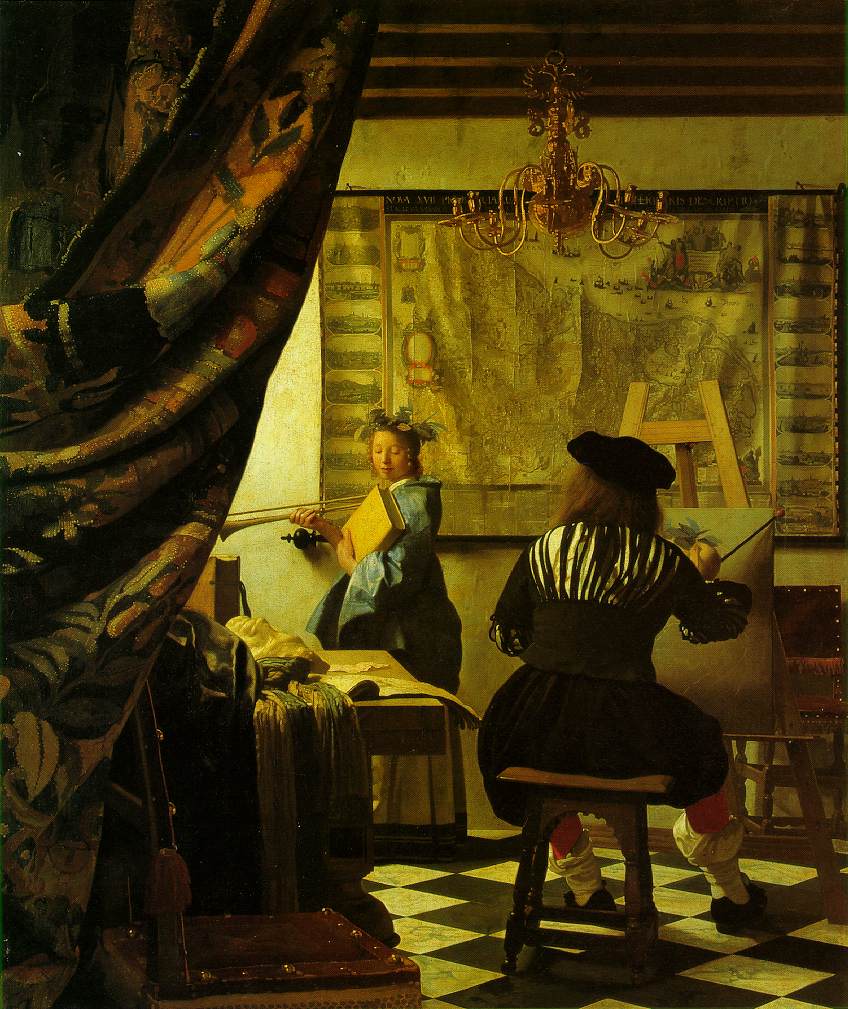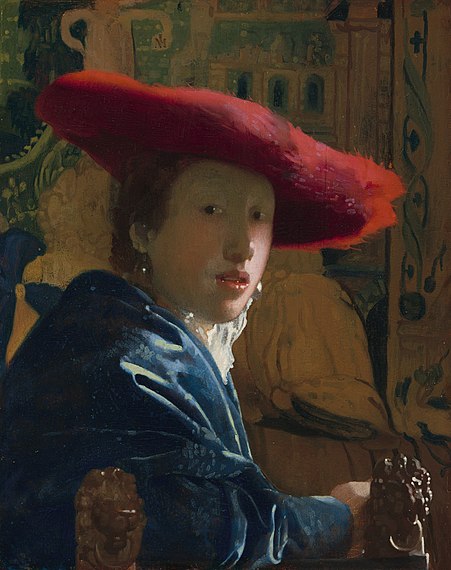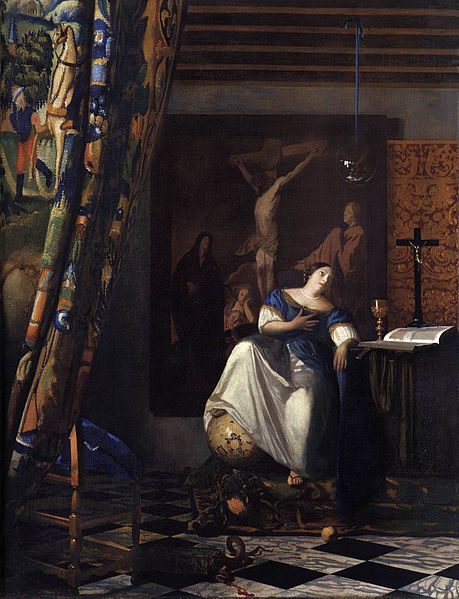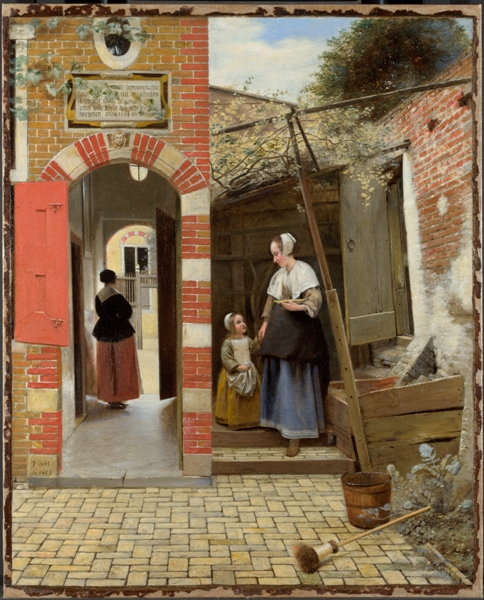Vermeer and the Delft School, a major international loan exhibition, premiered at The Metropolitan Museum of Art from March 8 through May 27, 2001. Best known for quiet, carefully described images of domestic life as seen in works by Johannes Vermeer, Pieter de Hooch, and others, Delft masters also produced history pictures in an international style, highly refined flower paintings, princely portraits, and superb examples of the decorative arts. Featuring 85 paintings – including 15 Vermeers – by 30 artists, about 35 drawings, and smaller selections of tapestries, gilded silver, and Delftware faience, the exhibition cast the familiar "Delft School" in a new light – one that emphasizes the roles of the neighboring court at The Hague, and of sophisticated patrons in Delft.
The exhibition was organized by The Metropolitan Museum of Art, New York, in collaboration with The National Gallery, London.
Although the paintings of Vermeer are often regarded as the culmination of realism in Dutch art, the exhibition reveals how earlier artistic developments in Delft paved the way for the achievements of Vermeer and his celebrated colleagues – Pieter de Hooch, Carel Fabritius, Emanuel de Witte, and others. The exhibition focused on the key decades of the 1650s and 1660s, but approximately one-third of the paintings on view date from the preceding 50 years.
The exhibition was organized both chronologically and thematically, with familiar and lesser-known artists exhibited together to illustrate common interests in style or subject matter during different decades in the century. Thus Vermeer's choice of themes, and especially his approach to space, preoccupation with light, and use of certain compositional schemes are seen as reflecting not only his own extraordinary powers of observation, but also his sophisticated understanding of current artistic conventions and contemporary trends in taste.
Vermeer was represented by 15 paintings in New York, including six works that were not seen in the 1995-96 monographic exhibition in Washington. There were 10 De Hoochs on view and 16 views of church interiors and other buildings by Emanuel de Witte, Gerard Houckgeest, Hendrick van Vliet, and others, as well as a selection of townscapes by Daniel Vosmaer and Egbert van der Poel. Several artists who briefly worked in Delft – Paulus Potter, Jan Steen, Adam Pynacker – were represented by outstanding works. Other painters who have been connected with the city, including so-called De Hooch School painters Pieter Janssens Elinga and Jacobus Vrel, were excluded because they never worked in Delft or the surrounding area. In addition to the well-known genre scenes, townscapes, and architectural views, the Delft School produced distinctive traditions of landscape and still-life painting, and these were also included in the exhibition.
Among the highlights of the paintings by Vermeer were such rarely lent masterpieces as

The Art of Painting (ca. 1667; Kunsthistorisches Museum, Vienna)

and The Procuress (1656; Staatliche Kunstsammlungen, Dresden).
Other works by Vermeer in the exhibition included

The Little Street (ca. 1658; Rijksmuseum, Amsterdam),

Girl with the Red Hat (ca. 1665; National Gallery of Art, Washington),
and the Metropolitan's own

Allegory of the Faith (ca. 1672).
Although they are similarly titled and were likely painted in the same year,

De Hooch's Portrait of a Family in a Courtyard in Delft (ca. 1658; Gemäldegalerie, Vienna)
and the more intimate and informal scene depicted in

The Courtyard of a House in Delft (1658; National Gallery, London)
differ greatly in both subject and style, revealing the artist's range in appealing to his patrons' wishes.
Two self-portraits by Fabritius as well as his much-loved

Goldfinch (1654; Mauritshuis, The Hague) were also on view.
The drawings and watercolors in the exhibition varied from preparatory sketches to finished drawings depicting views in Delft that are still recognizable today. A selection of delicate flower, shell, and other nature studies were among the highlights of works on paper. The tapestries in the exhibition included an extremely rare horse caparison – a full set of weavings to adorn a horse for parades and other celebratory pageants. On loan from the Royal Armory in Stockholm, the caparison was only used once and thus remains spectacularly vivid and well preserved. Other examples of decorative arts included cabinet bronzes and several pieces of silvergilt, illustrating the high level of artistry attained by Delft silversmiths.

The exhibition was accompanied by an illustrated catalogue published by The Metropolitan Museum of Art and distributed by Yale University Press. The 626-page publication features essays by Walter Liedtke, Michiel C. Plomp, and Axel Rüger, as well as several contributions by other international scholars.
Vermeer and the Delft School was organized by Walter Liedtke, Curator, Department of European Paintings at the Metropolitan, in consultation with Axel Rüger, Curator of Dutch Paintings, National Gallery, London.
Following the Metropolitan Museum's presentation, the exhibition was on view at The National Gallery, London, from June 20 through September 16, 2001.
Outstanding Review:
http://www.dooyoo.co.uk/museums-national/vermeer-and-the-delft-school/286137/